Tämä parodiatili ehti ennen Kremliä toteamaan asian oikean laidan viimeyön laivanupotuksesta..
Install the app
How to install the app on iOS
Follow along with the video below to see how to install our site as a web app on your home screen.
Note: This feature may not be available in some browsers.
You are using an out of date browser. It may not display this or other websites correctly.
You should upgrade or use an alternative browser.
You should upgrade or use an alternative browser.
Ukrainan konflikti/sota
Ja mitä ilmeisemmin lisää tulee kiihtyvään tahtiin kun venäjä kaivaa niitä varastojaan.Havainnollistettu kuvan avulla miltä näyttää erikoisoperaatiossa ryssän menettämät tankit yhdessä läjässä.
Tämä määrä oryxin vahvistamat, luultavasti todellinen määrä suurempi.
Keskimäärin 112 vaunua per kuukausi on ryssän tappiot olleet.Havainnollistettu kuvan avulla miltä näyttää erikoisoperaatiossa ryssän menettämät tankit yhdessä läjässä.
Tämä määrä oryxin vahvistamat, luultavasti todellinen määrä suurempi.
Roscosmoksen "avaruusmariinit" joutuneet Ukrainassa lannoitteeksi.
Nick Kane
Eversti
Huhua vielä mut ristus jos tää pitää paikkansa, joudutaanko korkkaamaan konut jo tänään
Muoks. tämä osottautui myöhemmin jonkin sortin käännöskukkaseksi, eli tässä ajatellaan kahta vastaavan kipon upotusta yhteensä / ei upotettu kuin yksi purkki lisää mikä toki hienoa sekin eikä yhtään vähäteltävää
Linkki
Muoks. tämä osottautui myöhemmin jonkin sortin käännöskukkaseksi, eli tässä ajatellaan kahta vastaavan kipon upotusta yhteensä / ei upotettu kuin yksi purkki lisää mikä toki hienoa sekin eikä yhtään vähäteltävää
Linkki
Viimeksi muokattu:
Sotavankeina olleita örkkejä palaamassa äiti-venäjän "lämpimään" syliin... 

Blyat! 
Örkkien evakuointi ottaa kopin kamikaze-dronesta.

Örkkien evakuointi ottaa kopin kamikaze-dronesta.
Harvapartio
Eversti
Tosiaan tuo suomennetaan "ovat upottaneet toisen", mutta luulisin että tässä tapauksessa tarkoitetaan "ovat jälleen upottaneet", eli puhuisi juuri tästä videoidusta tapauksesta. Mutta sivuhuomiona ihan turha käyttäjä tuo WarMonitor, kun ei laita lähteitä mihinkään.Huhua vielä mut ristus jos tää pitää paikkansa, joudutaanko korkkaamaan konut jo tänään
Linkki
Kustaanmiekka
Kenraali
Yhdysvallat keksi luovan keinon jatkaa Ukrainan sotilasapua – alkaa kierrättää kalustoa Kreikan välityksellä
Yhdysvallat keksi luovan keinon jatkaa Ukrainan sotilasapua – alkaa kierrättää kalustoa Kreikan välityksellä
Ilmari Käihkön mukaan suuri kysymys on, onko Euroopan mailla kykyä kasvattaa tukeaan Ukrainalle, kun Yhdysvaltain rooli näyttää pienenevän.
Kreikan hallitus on alkanut pikaisesti valmistella kahdenvälistä, sotilaallista tukipakettia Ukrainalle. Kreikka panee kasaan paketin, johon kuuluu muun muassa aseistusta ja tarvikkeita.
Itsestään Kreikka ei apupakettia keksinyt vaan pyyntö tuli suoraan Yhdysvalloilta, joka ei viime vuoden lopun jälkeen ole pystynyt sopimaan Ukrainan tuen jatkosta.
Yllättävintä Kreikan apupaketissa on se, että myös Ukrainalle luovuttava kalusto tulee Yhdysvalloilta. Asiasta ovet kertoneet kreikkalaiset tiedotusvälineet.
Presidentillä on oikeus määrätä lahjoitukselle hinta, nolla dollaria, kunhan Kreikka huolehtii kaluston siirtämisestä. Lupaa kongressilta ei tarvitse kysyä.
Yhdysvallat on liittänyt lahjoitukset ja niiden toimitukset Ukrainaan osaksi samaa sopimusta, jolla se myy Kreikalle 40 F-35-hävittäjää.
– Kyllä Yhdysvaltain hallinnossa ja tiedustelupalveluissa ymmärretään, että jos Ukrainaa ei tueta nyt ja Venäjä pääsee tavoitteeseensa, siitä tulee valtavia seurauksia kansainväliselle turvallisuudelle
missileman
Kenraali
Avdiivkan Coke Plant olisi Ukrainan hallinnassa jälleen
Antares
Respected Leader
Ainakin yhden Ka-52 kopterin osalta todistetusti harrastettu kannibalisointia:
Noticed this, too.
Here are two more stills images of Ka-52s from recently published Russian MoD videos that suggest cannibalization.
It's very plausible that several Ka-52s - including those damaged beyond economical repair - were cannibalized for parts.
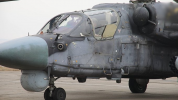
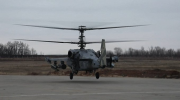
-
This Ka-52 has two different production codes, one on the fuselage and another on the rudder.
Cannibalization?
It is one of the last Ka-52s made, before switching to Ka-52M production in early 2023.
Meanwhile, the rudder comes from Ka-52 ‘83red’ RF-13422, manufactured in 2017.
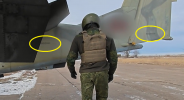
The Ka-52 ‘83red’ RF-13422 was once a very popular helicopter and performed at various events.
This is its flight over Red Square on 9 May 2018. Now, it has become a spare parts donor.
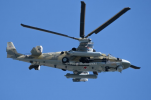
Noticed this, too.
Here are two more stills images of Ka-52s from recently published Russian MoD videos that suggest cannibalization.
It's very plausible that several Ka-52s - including those damaged beyond economical repair - were cannibalized for parts.


-
This Ka-52 has two different production codes, one on the fuselage and another on the rudder.
Cannibalization?
It is one of the last Ka-52s made, before switching to Ka-52M production in early 2023.
Meanwhile, the rudder comes from Ka-52 ‘83red’ RF-13422, manufactured in 2017.

The Ka-52 ‘83red’ RF-13422 was once a very popular helicopter and performed at various events.
This is its flight over Red Square on 9 May 2018. Now, it has become a spare parts donor.

Ehkä kun on tuota etäisyyttä ja en ole menettänyt mitään henk.koht. tasolla tässä sodassa, niin en saa mitään erityisiä kiksejä kun ryssiä menee fyysisesti palasiksi videoissa tms. mutta ai että tällainen 110% autenttinen rotupuhdas ryssän ulina on kuin jotain taivaallista sulosointuista musiikkia korville. Koko kehon valtaa lämmin tunne, sitä saa mitä tilaa



ps. viimeksi tuli näin hyvä mieli kun se yksi ulisi etelä-amerikassa että aina ryssän passia näyttämällä "why they treat us like shit"

Ja tietysti isot pudotukset/upotukset kuten tänään on ihan oma juhlan aiheensa

Viimeksi muokattu:
Minusta tuossa liikkuu miehistöä aluksen kannella, dronesta kauemmalla eli styyrpuurin laidalla. Osalla varmaan eristävämpää vedenpitävää vaatetta kansitehtäviä varten ja osa ohuemmissa komentokeskus/-siltahommiin sopivammissa, selittäisi erilaiset kirkkaudet per henkilö.On mahdollista että uponneen aluksen kaverina oli jokin toinen sotalaiva - kieltämättä videolla näyttää siltä että aluksen takana olisi toinen. Siitä ei ole näkynyt mainintaa eikä Ukrainakaan sanonut muuta kuin että upottivat tämän yhden:
After further analysis of the video released earlier by Ukrainian Defense, I believe there may possibly have been a second vessel in the vicinity providing assistance to the Russian Corvette, Ivanovets of the Russian Black Sea Fleet.
See videos below.
(Video slowed to x0.5)
Antares
Respected Leader
Rob Lee lainaa palasen tuoreesta kenraali Zaluzhny kirjoittamasta kolumnista (julkaistu 1.2.2024):
Zaluzhny: "We must acknowledge the significant advantage enjoyed by the enemy in mobilizing human resources"
"remain hamstrung by the imperfections of the regulatory framework in our country, as well as the partial monopolization of the defense industry"
https://edition.cnn.com/2024/02/01/...-strategy-russia-valerii-zaluzhnyi/index.html
Opinion by Valerii Zaluzhnyi
5 minute read
Updated 10:48 AM EST, Thu February 1, 2024
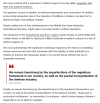
Zaluzhny: "We must acknowledge the significant advantage enjoyed by the enemy in mobilizing human resources"
"remain hamstrung by the imperfections of the regulatory framework in our country, as well as the partial monopolization of the defense industry"
https://edition.cnn.com/2024/02/01/...-strategy-russia-valerii-zaluzhnyi/index.html
Ukraine’s army chief: The design of war has changed
Opinion by Valerii Zaluzhnyi
5 minute read
Updated 10:48 AM EST, Thu February 1, 2024
https://edition.cnn.com/2024/02/01/...-strategy-russia-valerii-zaluzhnyi/index.html
Opinion by Valerii Zaluzhnyi
5 minute read
Updated 10:48 AM EST, Thu February 1, 2024

Commander-in-Chief of Ukraine’s armed forces, Valerii Zaluzhnyi, lays out his strategy for defeating Russia and the challenges holding his country back militarily.
General Staff of the Armed Forces of Ukraine
Editor’s Note: Valerii Zaluzhnyi has been Commander-in-Chief of the Armed Forces of Ukraine since 2021. This article was written before an expected announcement of his dismissal. The views expressed in this commentary are his own. Read a detailed CNN analysis of this article here.
CNN —
The Second World War drew to a close almost 80 years ago, but its legacy in defining the strategic vision of war persists to this day.
Whatever remarkable advances there have been in the fields of aviation, missile technology and space-based assets, for instance, the concept of victory remains unchanged: to destroy the enemy and to capture or liberate territory.
And yet, each war is unique.
And there is no greater challenge facing the military commander, in my opinion, than understanding – in good time – how each war is shaped differently.
Firstly, by technological progress, which determines the development of weapons and equipment.
And, secondly, by political conditions at home and abroad, and the economic environment.
Victory needs a unique strategy and follows a unique logic.
It is well known by now that a central driver of this war is the development of unmanned weapons systems.
They are proliferating at a breathtaking pace and the scope of their applications grows ever wider.
Crucially, it is these unmanned systems – such as drones – along with other types of advanced weapons, that provide the best way for Ukraine to avoid being drawn into a positional war, where we do not possess the advantage.
But while mastery of such technologies is key, it is not the only factor influencing current strategy.
We must contend with a reduction in military support from key allies, grappling with their own political tensions.
Our partners’ stocks of missiles, air defense interceptors and ammunition for artillery is becoming exhausted, due to the intensity of hostilities in Ukraine, but also from a global shortage of propellant charges.
Russia, taking note of how developments in the Middle East have distracted international attention, might seek to provoke further conflicts elsewhere.
The weakness of the international sanctions’ regime means Russia, in partnership with certain others, is still able to deploy its military-industrial complex in pursuit of a war of attrition against us.
We must acknowledge the significant advantage enjoyed by the enemy in mobilizing human resources and how that compares with the inability of state institutions in Ukraine to improve the manpower levels of our armed forces without the use of unpopular measures.

Finally, we remain hamstrung by the imperfections of the regulatory framework in our country, as well as the partial monopolization of the defense industry. These lead to production bottlenecks – in ammunition, for instance – which further deepen Ukraine’s dependence on its allies for supplies.
Our combat experience, particularly since 2022, is unique – but in the interests of victory, we must constantly find new ways and new capabilities to help us gain an advantage over the enemy.
Perhaps the number one priority here is mastery of an entire arsenal of (relatively) cheap, modern and highly effective, unmanned vehicles and other technological means.
Already such assets allow commanders to monitor the situation on the battlefield in real time, day and night, and in all weather conditions.
But not only that.
They provide real-time intelligence allowing the adjustment of fire around the clock, without pause – giving us the ability to deliver high-precision strikes against enemy targets in forward positions and in depth.
In short, this means nothing less than the wholesale redesign of battlefield operations – and the abandoning of outdated, stereotypical thinking.
New operations might include digital field creation, radio-electronic environment control, or a combined operation using attack drones and cyber assets.
Such operations will be coordinated and conducted under a single concept and plan.
Crucially, the aim will not always be solely combat in focus.
It might seek to reduce the economic capabilities of the enemy, or to isolate, or wear him down.
Attack operations can have psychological objectives.
That said, for the time being, the priority remains improving the situation on the battlefield.
And here, technology boasts an undoubted superiority over tradition.
The remote control of these assets means fewer soldiers in harm’s way, thus reducing the level of human losses.
It offers the opportunity to reduce (though certainly not eliminate) reliance on heavy materiel in combat missions and the overall conduct of hostilities.
And it opens up the possibility of inflicting sudden massive strikes against critical infrastructure facilities and communications hubs without deploying expensive missiles or manned aircraft.
Further advantages will become clear over time, though of course the enemy will all the time be looking for ways to defend against such operations and to seize or regain the initiative.
So, defense systems too need constant improvement, as do countermeasures targeting the use of new technology by the enemy.
The challenge for our armed forces cannot be underestimated.
It is to create a completely new state system of technological rearmament.
Taking everything into account at this moment, we think the creation of such a system could be achieved in five months.
Our partners are of the same view.
This time will be spent creating an appropriate organizational structure, filling and equipping positions, providing training and support, building out the supporting infrastructure and logistics, and developing a doctrinal framework.
In conclusion, in 2024, we must focus our main efforts in three areas.
Creating a system to provide our armed forces with high-tech assets.
Introducing a new philosophy of training and warfare which takes account of restrictions in assets and how they can be deployed.
And mastering new combat capabilities as soon as possible.
We already possess capabilities to eliminate the enemy and ensure the existence of statehood.
Our goal must be to seize the moment – to maximize our accumulation of the latest combat capabilities, which will allow us to commit fewer resources to inflicting maximum damage on the enemy, to end the aggression and protect Ukraine from it in the future.
-
Read a detailed CNN analysis of Valerii Zaluzhnyi’s opinion piece here.
-
Lainaan tekstin tuon linkin takaa, jos haluaa lukea CNN analyysin yllä olevasta kolumnista:
https://edition.cnn.com/2024/02/01/europe/zaluzhnyi-ukraine-russia-war-analysis-intl/index.html
Analysis by Andrew Carey, CNN
4 minute read
Updated 10:52 AM EST, Thu February 1, 2024

In his article, Ukraine's army chief said an end to “outdated, stereotypical thinking” was needed to help modern armies win wars.
Sergei Chuzavkov/AFP/Getty Images
KyivCNN —
Ukraine’s embattled army chief, Valerii Zaluzhnyi, says Ukraine must adapt to a reduction in military aid from its key allies and focus ever more strongly on technology if it is to win its war against Russia.
In an Opinion piece for CNN, submitted amidst a swirl of rumors surrounding his future, Zaluzhnyi also addressesed the challenge of mass mobilization, a source of tension between himself and President Volodymyr Zelensky.
The general’s article makes no reference to his relationship with the president, nor to reports Zelensky is poised to announce his dismissal after four years in the job, a move a source said could come within days.
Instead, the military commander seeks to build on an argument in an essay published three months ago, in addition to commenting for the first time on a series of political setbacks at home and abroad.
In that first essay, published in the Economist, Zaluzhnyi highlighted the importance of unmanned aerial vehicles and electronic warfare capabilities, as a priority for Ukraine, before concluding, “New innovative approaches can turn this war of position into one of maneuver.”
Zaluzhnyi’s characterization of the situation as a war of position – one defined by attrition and a lack of movement on the battlefield – amounted to a recognition that the Ukrainian counteroffensive, launched to great fanfare earlier in 2023, was effectively over.
Expectations earlier in the year were high that Ukraine could go on the attack and drive forward, conducting a war of maneuver to recapture significant amounts of territory lost to Russia in 2022.
But deep Russian minefields and heavy Russian artillery fire, along with the rapid proliferation of First-Person-View (FPV) drones across the frontlines, making stealth attacks much harder, proved difficult to overcome.
In the south, the primary focus of the effort, Ukrainian forces advanced about 20 kilometers; the hope had been they might be able to make it all the way to the coast, about 70 kilometers away.
When Zaluzhny - in a separate interview at the same time - referred to the situation as a ‘stalemate,’ Zelensky’s office snapped, saying such talk only helped Russia.
In his article for CNN, it seems clear Zaluzhnyi views the state of the war no differently.
Now, though he clearly believes Ukraine’s military leaders must take account of a series of disappointments and distractions away from the battlefield as well.
Indirectly, he references the failure of the United States to agree a new military aid package for Ukraine, as well as the fact that developments in the Middle East since October have drawn international attention elsewhere.
In addition, “the weakness of the international sanctions’ regime means Russia … is still able to deploy its military-industrial complex in pursuit of a war of attrition against us.”
He does not say it in as many words, but the article seems to suggest a growing sense that, ultimately, Ukraine’s fate is in its own hands.
An attitude of self-help is not new in Ukraine, of course.
It has prioritized its home-grown drone industry, for instance, notching up successes both in its sea drone program, striking Russian naval targets in the Black Sea, and with its long-range aerial drones, flying hundreds of kilometers to hit sites in and around Russia’s largest cities.
But domestic problems are clearly a concern, as when Zaluzhnyi references the apparent reluctance of his political masters in Kyiv to get fully behind his call for greater mobilization for up to half a million draftees, an acknowledgment of Russia’s overwhelmingly superior troop numbers.
“We must acknowledge the significant advantage enjoyed by [Russia] in mobilizing human resources and how that compares with the inability of state institutions in Ukraine to improve the manpower levels of our armed forces without the use of unpopular measures,” he writes.
In a society possibly reluctant to put large numbers of young men and women directly in harm’s way, remote-controlled drones provide a more acceptable type of combat operation, as he acknowledges.
Technology, he writes at one point, “boasts an undoubted superiority over tradition.”
But its importance goes much further, he says, as he sets out his belief that unmanned aerial vehicles, along with other high-tech capabilities have revolutionized not just combat operations but the overall approach to strategy, too.
Only an end to “outdated, stereotypical thinking” can help modern armies achieve victory in war, he writes.
Ukraine’s army chief: The design of war has changed
Opinion by Valerii Zaluzhnyi
5 minute read
Updated 10:48 AM EST, Thu February 1, 2024

Commander-in-Chief of Ukraine’s armed forces, Valerii Zaluzhnyi, lays out his strategy for defeating Russia and the challenges holding his country back militarily.
General Staff of the Armed Forces of Ukraine
Editor’s Note: Valerii Zaluzhnyi has been Commander-in-Chief of the Armed Forces of Ukraine since 2021. This article was written before an expected announcement of his dismissal. The views expressed in this commentary are his own. Read a detailed CNN analysis of this article here.
CNN —
The Second World War drew to a close almost 80 years ago, but its legacy in defining the strategic vision of war persists to this day.
Whatever remarkable advances there have been in the fields of aviation, missile technology and space-based assets, for instance, the concept of victory remains unchanged: to destroy the enemy and to capture or liberate territory.
And yet, each war is unique.
And there is no greater challenge facing the military commander, in my opinion, than understanding – in good time – how each war is shaped differently.
Firstly, by technological progress, which determines the development of weapons and equipment.
And, secondly, by political conditions at home and abroad, and the economic environment.
Victory needs a unique strategy and follows a unique logic.
It is well known by now that a central driver of this war is the development of unmanned weapons systems.
They are proliferating at a breathtaking pace and the scope of their applications grows ever wider.
Crucially, it is these unmanned systems – such as drones – along with other types of advanced weapons, that provide the best way for Ukraine to avoid being drawn into a positional war, where we do not possess the advantage.
But while mastery of such technologies is key, it is not the only factor influencing current strategy.
We must contend with a reduction in military support from key allies, grappling with their own political tensions.
Our partners’ stocks of missiles, air defense interceptors and ammunition for artillery is becoming exhausted, due to the intensity of hostilities in Ukraine, but also from a global shortage of propellant charges.
Russia, taking note of how developments in the Middle East have distracted international attention, might seek to provoke further conflicts elsewhere.
The weakness of the international sanctions’ regime means Russia, in partnership with certain others, is still able to deploy its military-industrial complex in pursuit of a war of attrition against us.
We must acknowledge the significant advantage enjoyed by the enemy in mobilizing human resources and how that compares with the inability of state institutions in Ukraine to improve the manpower levels of our armed forces without the use of unpopular measures.

Finally, we remain hamstrung by the imperfections of the regulatory framework in our country, as well as the partial monopolization of the defense industry. These lead to production bottlenecks – in ammunition, for instance – which further deepen Ukraine’s dependence on its allies for supplies.
Our combat experience, particularly since 2022, is unique – but in the interests of victory, we must constantly find new ways and new capabilities to help us gain an advantage over the enemy.
Perhaps the number one priority here is mastery of an entire arsenal of (relatively) cheap, modern and highly effective, unmanned vehicles and other technological means.
Already such assets allow commanders to monitor the situation on the battlefield in real time, day and night, and in all weather conditions.
But not only that.
They provide real-time intelligence allowing the adjustment of fire around the clock, without pause – giving us the ability to deliver high-precision strikes against enemy targets in forward positions and in depth.
In short, this means nothing less than the wholesale redesign of battlefield operations – and the abandoning of outdated, stereotypical thinking.
New operations might include digital field creation, radio-electronic environment control, or a combined operation using attack drones and cyber assets.
Such operations will be coordinated and conducted under a single concept and plan.
Crucially, the aim will not always be solely combat in focus.
It might seek to reduce the economic capabilities of the enemy, or to isolate, or wear him down.
Attack operations can have psychological objectives.
That said, for the time being, the priority remains improving the situation on the battlefield.
And here, technology boasts an undoubted superiority over tradition.
The remote control of these assets means fewer soldiers in harm’s way, thus reducing the level of human losses.
It offers the opportunity to reduce (though certainly not eliminate) reliance on heavy materiel in combat missions and the overall conduct of hostilities.
And it opens up the possibility of inflicting sudden massive strikes against critical infrastructure facilities and communications hubs without deploying expensive missiles or manned aircraft.
Further advantages will become clear over time, though of course the enemy will all the time be looking for ways to defend against such operations and to seize or regain the initiative.
So, defense systems too need constant improvement, as do countermeasures targeting the use of new technology by the enemy.
The challenge for our armed forces cannot be underestimated.
It is to create a completely new state system of technological rearmament.
Taking everything into account at this moment, we think the creation of such a system could be achieved in five months.
Our partners are of the same view.
This time will be spent creating an appropriate organizational structure, filling and equipping positions, providing training and support, building out the supporting infrastructure and logistics, and developing a doctrinal framework.
In conclusion, in 2024, we must focus our main efforts in three areas.
Creating a system to provide our armed forces with high-tech assets.
Introducing a new philosophy of training and warfare which takes account of restrictions in assets and how they can be deployed.
And mastering new combat capabilities as soon as possible.
We already possess capabilities to eliminate the enemy and ensure the existence of statehood.
Our goal must be to seize the moment – to maximize our accumulation of the latest combat capabilities, which will allow us to commit fewer resources to inflicting maximum damage on the enemy, to end the aggression and protect Ukraine from it in the future.
-
Read a detailed CNN analysis of Valerii Zaluzhnyi’s opinion piece here.
-
Lainaan tekstin tuon linkin takaa, jos haluaa lukea CNN analyysin yllä olevasta kolumnista:
https://edition.cnn.com/2024/02/01/europe/zaluzhnyi-ukraine-russia-war-analysis-intl/index.html
Embattled army chief lays bare Ukraine’s challenges, at home and abroad
Analysis by Andrew Carey, CNN
4 minute read
Updated 10:52 AM EST, Thu February 1, 2024

In his article, Ukraine's army chief said an end to “outdated, stereotypical thinking” was needed to help modern armies win wars.
Sergei Chuzavkov/AFP/Getty Images
KyivCNN —
Ukraine’s embattled army chief, Valerii Zaluzhnyi, says Ukraine must adapt to a reduction in military aid from its key allies and focus ever more strongly on technology if it is to win its war against Russia.
In an Opinion piece for CNN, submitted amidst a swirl of rumors surrounding his future, Zaluzhnyi also addressesed the challenge of mass mobilization, a source of tension between himself and President Volodymyr Zelensky.
The general’s article makes no reference to his relationship with the president, nor to reports Zelensky is poised to announce his dismissal after four years in the job, a move a source said could come within days.
Instead, the military commander seeks to build on an argument in an essay published three months ago, in addition to commenting for the first time on a series of political setbacks at home and abroad.
In that first essay, published in the Economist, Zaluzhnyi highlighted the importance of unmanned aerial vehicles and electronic warfare capabilities, as a priority for Ukraine, before concluding, “New innovative approaches can turn this war of position into one of maneuver.”
Zaluzhnyi’s characterization of the situation as a war of position – one defined by attrition and a lack of movement on the battlefield – amounted to a recognition that the Ukrainian counteroffensive, launched to great fanfare earlier in 2023, was effectively over.
Expectations earlier in the year were high that Ukraine could go on the attack and drive forward, conducting a war of maneuver to recapture significant amounts of territory lost to Russia in 2022.
But deep Russian minefields and heavy Russian artillery fire, along with the rapid proliferation of First-Person-View (FPV) drones across the frontlines, making stealth attacks much harder, proved difficult to overcome.
In the south, the primary focus of the effort, Ukrainian forces advanced about 20 kilometers; the hope had been they might be able to make it all the way to the coast, about 70 kilometers away.
When Zaluzhny - in a separate interview at the same time - referred to the situation as a ‘stalemate,’ Zelensky’s office snapped, saying such talk only helped Russia.
In his article for CNN, it seems clear Zaluzhnyi views the state of the war no differently.
Now, though he clearly believes Ukraine’s military leaders must take account of a series of disappointments and distractions away from the battlefield as well.
Indirectly, he references the failure of the United States to agree a new military aid package for Ukraine, as well as the fact that developments in the Middle East since October have drawn international attention elsewhere.
In addition, “the weakness of the international sanctions’ regime means Russia … is still able to deploy its military-industrial complex in pursuit of a war of attrition against us.”
He does not say it in as many words, but the article seems to suggest a growing sense that, ultimately, Ukraine’s fate is in its own hands.
An attitude of self-help is not new in Ukraine, of course.
It has prioritized its home-grown drone industry, for instance, notching up successes both in its sea drone program, striking Russian naval targets in the Black Sea, and with its long-range aerial drones, flying hundreds of kilometers to hit sites in and around Russia’s largest cities.
But domestic problems are clearly a concern, as when Zaluzhnyi references the apparent reluctance of his political masters in Kyiv to get fully behind his call for greater mobilization for up to half a million draftees, an acknowledgment of Russia’s overwhelmingly superior troop numbers.
“We must acknowledge the significant advantage enjoyed by [Russia] in mobilizing human resources and how that compares with the inability of state institutions in Ukraine to improve the manpower levels of our armed forces without the use of unpopular measures,” he writes.
In a society possibly reluctant to put large numbers of young men and women directly in harm’s way, remote-controlled drones provide a more acceptable type of combat operation, as he acknowledges.
Technology, he writes at one point, “boasts an undoubted superiority over tradition.”
But its importance goes much further, he says, as he sets out his belief that unmanned aerial vehicles, along with other high-tech capabilities have revolutionized not just combat operations but the overall approach to strategy, too.
Only an end to “outdated, stereotypical thinking” can help modern armies achieve victory in war, he writes.

Siitä iltasaduksi seikkailukertomus, kuinka vallataan sillanpäätä ryssältä. On ne hurjia ukkoja


Olettaisin, että lastattuna useammalla paukulla, toiminta aika/matka lie rajallinen, parempi tiputtaa jo löydettyyn "Bonus" paukku, kuin sitten kotio matkalla johonkin puskaan... tuskin vievät namuja takaisin kotipesään, lie aika hazardia sellainen?En ymmärrä yksittäisen vihollisen dronettamista useammilla paukuilla, kyllähän yksikin ranun tiputus näyttää vievän kohteen tuonelaan, vaikkakin ei heti.
Näin jäisi muut pudotteet taas seuraaville vihollisille.
Ennakoltahan tuossa on varmasti tiedossa ne kohteet, siis ennen tuollaisen moni-paukku-kopterin laittamista matkaan (tieto varmaan korkeammalla lentävästä tarkkailu dronesta tms.)
J0h1F
Respected Leader
Katso liite: 92526
Eli keltaisessa raksissa on nyt uusi sillanpää. Jos punaisen ympyrän sisälle tulee kolmas sillanpää niin sitten uskon hyökkäyksen alkavan Dneprjoen yli. Toki tämä voi olla myös harhautusta ja isompi hyökkäys tulisi muualla mutta kuitenkin. Odotellaan.
EDIT. Lisään vielä, että tuolla punaisen ympyrän alueella Ukraina on harjoitellut ennen sotaa joen ylitystä muistaakseni Brittien kanssa, vai oliko Ranskan, mutta kuitenkin.
Tuon punaisen ympäröidyn alueen ongelmana on se, että padon räjäytys huuhtoi siitä tiet pois itärannalta, siinähän oli sitä ennen hyvät lauttarannat joen molemmin puolin, ja myös tiet, joita jatkaa. Moni ilmakuva tai kartta ei vain vielä näytä tuon nykytilannetta.
